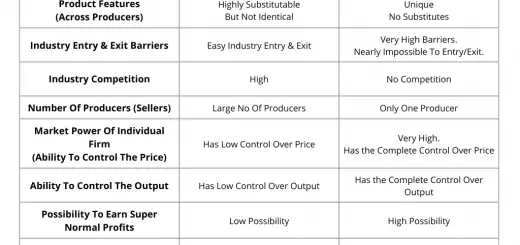Oligopoly Market – Seven Important Characteristics
An oligopoly market can be identified with seven main characteristics. These are also known as the market conditions to enable oligopoly.
1. Barriers to Entry
Markets with oligopolies naturally have high barriers to entry. As an example; patents, licenses, high start-up costs, etc. These make it difficult for new entrants to join the competition.
Example: New entry for the telecommunication industry requires a high initial investment.
Example: New entry for the pharmaceutical industry requires patents and licenses which is very difficult to obtain.
2. Few Firms with Large Market Share
In an oligopoly market, it may have many firms, but the top 5 firms have a combined market share of over 50 percent. This is because the market power is concentrated between a few top firms.
Example: The mobile operating system market in America and worldwide is dominated by two big tech giants: Google and Apple. You can read more by viewing: Oligopoly Market – Real Examples in the USA & Canada.
3. Each Firm Has Minor Own Market Power
Power is distributed among firms in the oligopoly market. Each firm has little market power in an oligopoly market. One oligopolistic firm cannot dictate prices independently.
Example: In an oligopoly market, if a firm raises its product price then there is a risk of losing customers. Customers will attract to the other firms due to pricing constraints.
4. Higher Prices Than Perfect Competition
Firms in an oligopoly market have combined market power, which all firms usually tend to keep prices higher to obtain larger profits.
Example: It is commonly visible in the pharmaceutical industry where firms are not decreasing prices drastically.
5. Inter Dependency Between Firms
Any action taken on one film will strongly affect the actions of its competitors (other firms) in an oligopoly market. A firm in an oligopoly market operates based on competitor actions. If one firm reduces prices, other firms will also tend to follow the same to safeguard their market share.
Example: In the mobile network operator industry, it is commonly visible that if one firm introduced a package with a low price, other firms will also introduce similar kinds of packages with low prices.
6. Efficiency
Firms in an oligopoly market benefit from high levels of market share which they naturally benefit from economies of scale. Firms can the product at a lower cost.
Example: Toyota invested heavily in their lean production system (Toyota Production System). This resulted in quality improvements, waste reductions, customer satisfaction improvements, which result in technical economies of scale by reducing the unit cost of production.
You can read more examples of economies of scale by viewing: Types of Internal Economies of Scale with Industry Examples.
7. No Unique Pattern In Pricing
Each firm is keen to remain independent in an oligopoly market and is also targetted to get the maximum possible profit. They react to the price-output movements of one another which are a continuous element of uncertainty.
Example: If one firm reduces the prices then others will also follow the same to retain customers.
Read More:
Market Structures
Oligopoly Market
- Definition, Types, and Characteristics of Oligopoly Market
- Real Examples of Oligopoly Market (in the USA, Canada, World)
- Advantages and Disadvantages of Oligopoly Market
Monopoly Market
- Definition, Examples, and Characteristics of Monopoly Market
- Real Examples of Monopoly Market (in the USA, Canada, Australia, World)
- Important Characteristics / Causes of Monopoly Market
- Advantages and Disadvantages of Monopoly Market
Monopolistic Competition
- Overview, Definition, & Features of Monopolistic Competition
- Main Characteristics / Causes of Monopolistic Competition
- Real Examples of Monopolistic Competition (in USA, Canada, World)
- Advantages and Disadvantages of Monopolistic Competition
Perfect Competition


